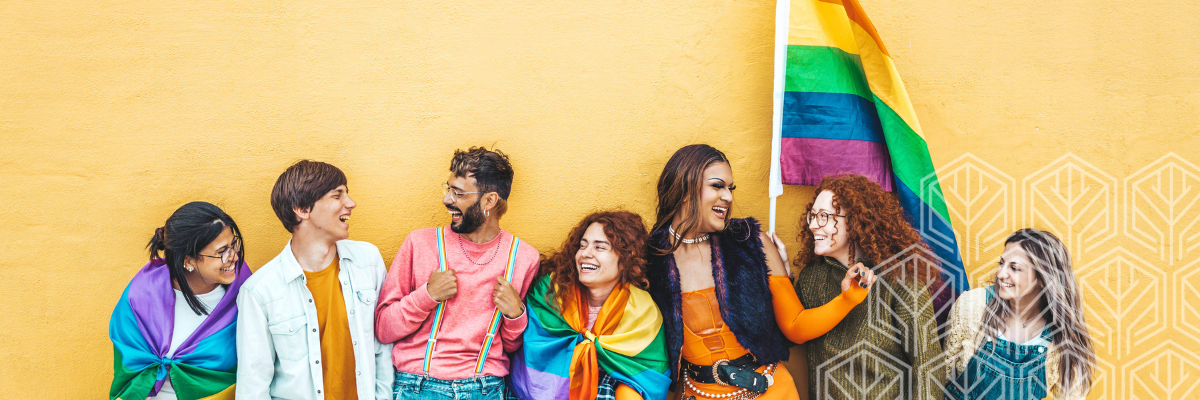[vc_row][vc_column][vc_column_text title=”Pride is Being There for Each Other” css=”.vc_custom_1717529719709{margin-bottom: 0px !important;}”]Nowadays, the word “Pride” is almost immediately associated with “Parade” in many people’s minds. But in the LGBT2SQ+ community we know that at its inception “Pride” went with “Protest”.
Most people think of the Stonewall Riots as the start of the gay liberation movement in North America. Here in Toronto, we had a similar watershed moment that acted as a catalyst for the emergence of the June Pride Festival. On February 5, 1981, Metropolitan Toronto Police initiated Operation Soap. Four Toronto bathhouses were raided and over 300 men were arrested. This was the largest mass arrest in Canadian history at the time. The arrests caused careers and families to be destroyed. The event sparked nation-wide protests and was an important turning point for Queer and Trans liberation in Canada.
These protests and rallies denouncing Operation Soap evolved into the Toronto Pride Festival, one of the largest pride festivals in the world.
In the four and a half decades since Operation Soap, there have been many reasons for our community to celebrate. We’ve made important strides forward like marriage equality and easier access to family-building. And by celebrating our identities, we resist the pressure to hide, assimilate, and deny our truth.
However, Pride still needs to be a protest. Backlash is here and it’s a real threat. Unfortunately, children seem to be the primary targets of this backlash. There is a movement aiming to make it hard for kids with queer parents to talk openly about their families and be affirmed at school while making it difficult for kids with cis, straight parents to learn that queers exist and humanize them. This movement also aims to force educators to disclose confidential information about the gender identity of their students, which would inevitably expose some of these children to abuse. A federal ban on conversion therapy in 2022 has simply driven the practice more underground, and no charges have been laid under the new legislation. Kids can’t show up to listen to drag queens read stories without having to walk past a phalanx of angry anti-trans protestors.
We can drown out this hateful backlash with a flood of compassion. It starts by declaring proudly and unequivocally that you affirm queer and trans people in your birth work practice. Then, you bring the skills to the table.
Here’s a guide to resources that can support you in growing a queer and trans-competent birthwork practice.
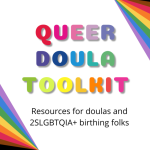 This free download developed by Wellness Within and Nova Scotia Public Interest Research Group (NPIRG) is a must-have resource for birth workers supporting queer and trans clients. It is choc full of educational resources and fillable exercises. Some of these are on topics that are relevant to the 2SLGBTQ communities, like pronouns, queer families, and queer terminology. Others go over the usual perinatal health topic in a queer-trans-inclusive way. The toolkit is illustrated with vividly realized characters encompassing humans of all shapes, sizes, colours, gender presentations, abilities, and family structures.
This free download developed by Wellness Within and Nova Scotia Public Interest Research Group (NPIRG) is a must-have resource for birth workers supporting queer and trans clients. It is choc full of educational resources and fillable exercises. Some of these are on topics that are relevant to the 2SLGBTQ communities, like pronouns, queer families, and queer terminology. Others go over the usual perinatal health topic in a queer-trans-inclusive way. The toolkit is illustrated with vividly realized characters encompassing humans of all shapes, sizes, colours, gender presentations, abilities, and family structures.
The fillable exercises include a queer-affirming and trauma-informed birth plan. The birth plan is supported by trauma-informed reflections that ask the client to reflect on their triggers and potential coping strategies. The strategies can be documented in the plan, including how their doula can help.
Books & TV
Why Did No One Tell Me This? The doulas’ honest guide for expectant parents.
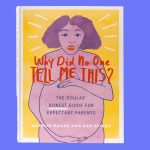
This book is a great resource for parents and birth workers. It’s not specifically queer, but it is written from an intersectional standpoint and uses inclusive language and imagery throughout. It’s a great option for parents looking to supplement their prenatal class or work with a doula and affirms a wide range of birthing people.
 If the older sibling of a gayby (child of same-sex parents) wants to know where their new sibling came from, this is the book for them. Appropriate for early-years children, it answers the question “Where do babies come from?” in a way that is scientific and inclusive of the various ways in which queer and trans people family-build.
If the older sibling of a gayby (child of same-sex parents) wants to know where their new sibling came from, this is the book for them. Appropriate for early-years children, it answers the question “Where do babies come from?” in a way that is scientific and inclusive of the various ways in which queer and trans people family-build.
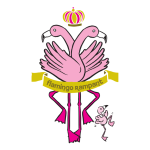 This independent children’s press has a beautiful and ever-growing selection of children’s books that celebrate the diversity of families and identities. Operating from an intersectional social justice lens, this publisher prioritizes stories about gender and sexually diverse children, youth, adults and families doing things that are bold, cool, adventurous and fun without making identity the focus of the story. Each book radiates a message of joy, acceptance, community, and love.
This independent children’s press has a beautiful and ever-growing selection of children’s books that celebrate the diversity of families and identities. Operating from an intersectional social justice lens, this publisher prioritizes stories about gender and sexually diverse children, youth, adults and families doing things that are bold, cool, adventurous and fun without making identity the focus of the story. Each book radiates a message of joy, acceptance, community, and love.
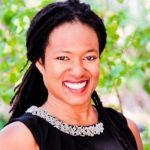
Keira Grant (she/her) Inclusion and Engagement Lead – Racialized Communities
Keira brings a wealth of experience to the Online Community Moderator role. She is a Queer, Black woman with a twenty-year track record in Equity, Diversity, and Inclusion (EDI) education, projects, and community building initiatives.[/vc_column_text][/vc_column][/vc_row]
